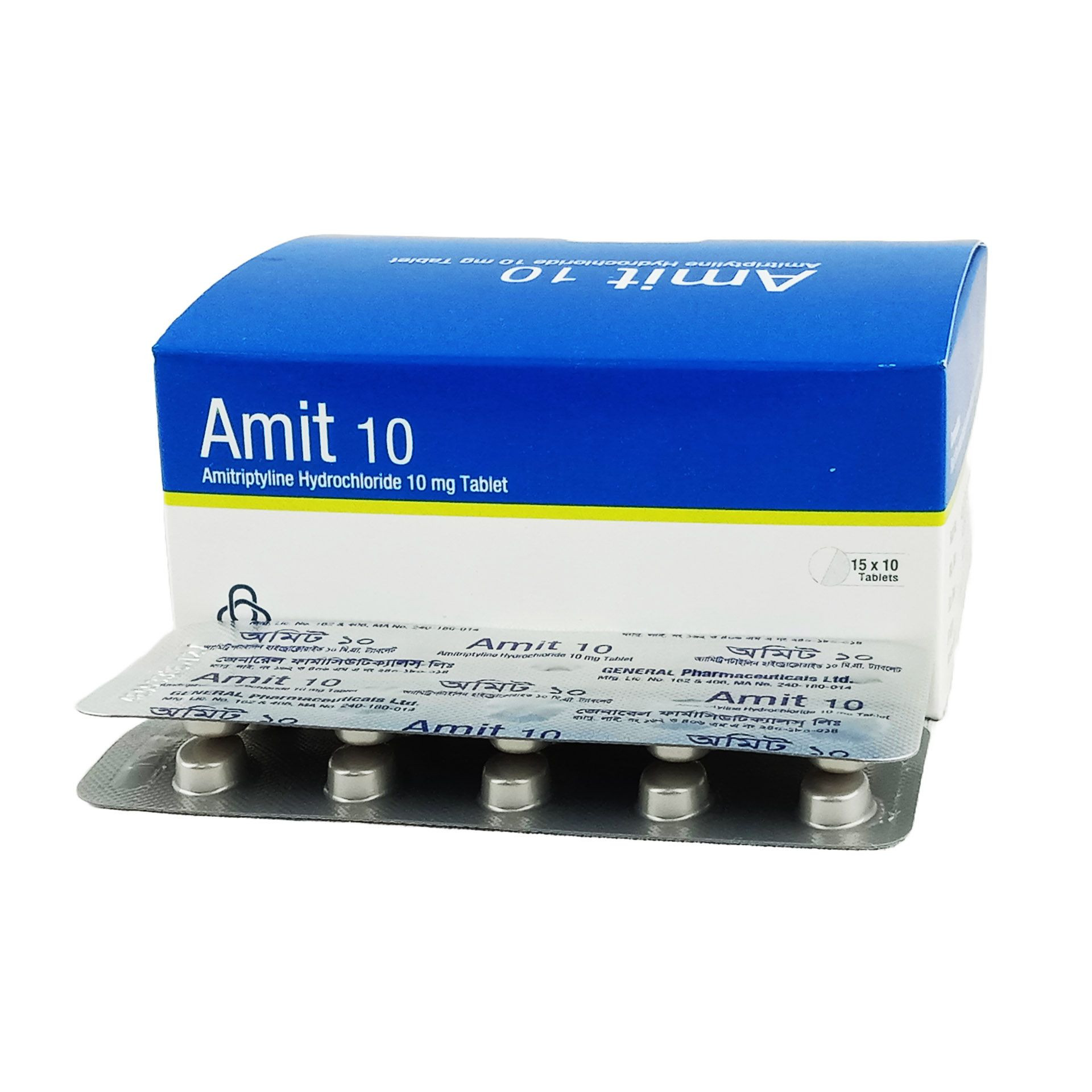Unit Price:
৳ 0.85
(15 x 10: ৳ 127.50)
Strip Price:
৳ 8.50
Also available as:
Indications
Amit is indicated in-
- Depressive Illness: particularly where sedation is required.
- Nocturnal Enuresis in children.
- Prophylaxis of Migraine.
- Tension Headache.
- Chronic Pain.
* রেজিস্টার্ড চিকিৎসকের পরামর্শ মোতাবেক ঔষধ সেবন করুন
Description
Amit is a tricyclic antidepressant. It has marked anticholinergic and sedative properties. It prevents the reuptake of noradrenaline and serotonin at the nerve ending. Amit is rapidly absorbed from the Gl tract. Peak plasma concentrations occur within 2-12 hours. Amit is excreted in the urine, mainly in the form of its metabolites.
Pharmacology
The mechanism of action of this drug is not fully elucidated. It is suggested that amitriptyline inhibits the membrane pump mechanism responsible for the re-uptake of transmitter amines, such as norepinephrine and serotonin, thereby increasing their concentration at the synaptic clefts of the brain. These amines are important in regulating mood. The monoamine hypothesis in depression, one of the oldest hypotheses, postulates that deficiencies of serotonin (5-HT) and/or norepinephrine (NE) neurotransmission in the brain lead to depressive effects. This drug counteracts these mechanisms, and this may be the mechanism of amitriptyline in improving depressive symptoms. Whether its analgesic effects are related to its mood-altering activities or attributable to a different, less obvious pharmacological action (or a combination of both) is unknown.
Dosage & Administration
Depression: Initially 75 mg (Elderly and Adolescents 30-75 mg) daily in divided doses or as a single dose at bedtime increased gradually as necessary to 150-200 mg; Child under 16 years not recommended for depression.
Nocturnal Enuresis: Child 7-10 years: 10-20 mg, 11-16 years: 25-50 mg at night; max. period of treatment (including gradual withdrawal) 3 months-full physical examination before the further course.
Prophylaxis of Migraine: 100 mg daily.
Tension Headache: 10-25 mg three times daily.
Nocturnal Enuresis: Child 7-10 years: 10-20 mg, 11-16 years: 25-50 mg at night; max. period of treatment (including gradual withdrawal) 3 months-full physical examination before the further course.
Prophylaxis of Migraine: 100 mg daily.
Tension Headache: 10-25 mg three times daily.
* রেজিস্টার্ড চিকিৎসকের পরামর্শ মোতাবেক ঔষধ সেবন করুন
Interaction
TCA enhances the sedative effect of alcohol and opioid analgesics. When TCA is used with Moxifloxacin or Terfenadine, it increases the risk of ventricular arrhythmias. Disulfirum and Cimetidine inhibit the metabolism of Amit. When TCA is used with diuretics, it enhances the risk of postural hypotension.
Contraindications
Amitriptyline is contraindicated in myocardial infarction, arrythmias, particularly heart block of any degree, mania and severe liver disease. Initially, sedation may affect the ability to drive or operate machinery.
Side Effects
- Anticholinergic: Excessive perspiration, dry mouth, blurred vision, hyperpyrexia, urinary retention and urinary tract dilatation.
- Cardiovascular reactions: Hypotension, syncope, postural hypotension, hypertension, tachycardia, palpitations, myocardial infarction, etc.
- CNS and Neuromuscular: Confusional states, disturbed concentration, disorientation, delusions, etc.
- Allergic: Skin rash, urticaria, photosensitization, etc.
- Haematological: Bone-marrow depression.
- Gastrointestinal: Nausea, epigastric distress, vomiting, anorexia, stomatitis, unpleasant taste, weight loss, diarrhoea, constipation, etc.
- Endocrine: Testicular swelling, gynaecomastia, breast enlargement, galactorrhoea, etc.
Pregnancy & Lactation
Pregnancy Category C. Amitriptyline has been shown to cross the placenta. Amitriptyline should be used during pregnancy only if the potential benefit to the mother justifies the potential risk to the fetus. Amitriptyline is excreted into breast milk. Because of the potential for serious adverse reactions in nursing infants from Amitriptyline, a decision should be made whether to discontinue nursing or to discontinue the drug, taking into account the importance of the drug to the mother.
Precautions & Warnings
It should be used with caution in patients with a history of epilepsy, glaucoma, urinary retention, cardiac disease, diabetes, pregnancy, hepatic impairment, thyroid disease, increased intra-ocular pressure and psychoses (may aggravate mania).
Therapeutic Class
Tricyclic Anti-depressant
Storage Conditions
Store in a cool and dry place, below 30°C. Protect from light and moisture.

